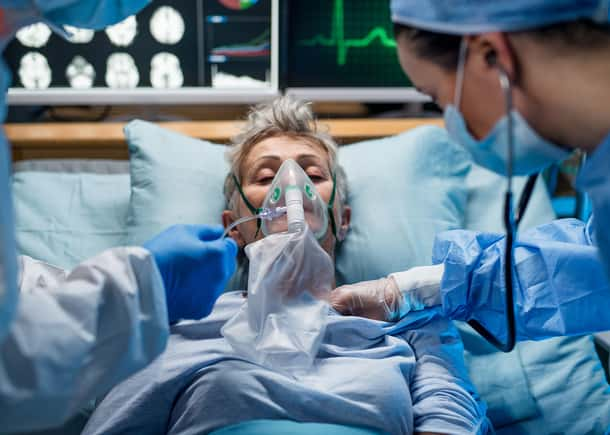SimMan 3G PLUS
Built on decades of expertise, SimMan 3G PLUS offers a fully immersive simulation experience with heightened realism.
Using Simulation to Prepare Healthcare Professionals

The World Health Organization (WHO) has called the coronavirus (COVID-19) the defining global health crisis of our time.1 For hospital providers, this is particularly true. As the first COVID-19 patient cases were reported in the U.S., there were still many holes in the scientific community’s knowledge – and this meant that healthcare professionals were at the mercy of new updates every single day. They had to learn how to adapt on-the-fly, with less than the necessary resources.
COVID-19 has raised many questions about care protocols, patient needs, hospital layouts, and how to prepare for the unexpected. Simulation training is intended to provide practice for situations one hopes will never arise. It can also be used as a powerful tool to improve healthcare responses. As hospital systems debrief about their experiences over the past few months, it is worth considering simulation as a means to improve and build upon existing efforts.
Here, we share what some hospitals have identified as their lessons learned from the coronavirus and how simulation training can help moving forward.

As a result of 9/11, hospitals redesigned departments and protocols to better respond to terrorist events.2 Now, future hospitals will likely be designed to better respond to pandemic events.
In a pandemic, experts agree that built-in flexibility is needed in the structure and layout of hospitals.3 Facilities did what they could with what they had as COVID-19 patients increased. Now, organizations are looking at ways to act more strategically. This might include ways to expand bed count beyond the standard model or how to isolate different areas of the hospitals with separate air filtration systems. And, whereas hospitals typically would not stockpile more supplies than they require for the average number of patients, they are now beginning to keep larger amounts of supplies on hand.
An organization will likely begin by evaluating their current blueprint with an eye toward bed space in each unit, storage, the amount of personal protective equipment (PPE), the number of mechanical ventilators, and the location of each temporary or permanent anteroom. One of the most useful ways to examine the healthcare space and identify flaws is to use in situ simulation – which is a form of team-based simulations run in the real clinical environment. In addition to testing the logical flow of the room, in situ simulation has been proven to improve teamwork, communication skills, and patient safety outcomes.4
As one of the few interventions shown to benefit patients with COVID-19 is mechanical ventilation, there has been an increased focus on the skills required to manage a ventilator. Typically, these skills are exclusive to the respiratory therapist or intensivist and, at almost 50% of hospitals, there is not an intensivist who regularly performs rounds.5
In addition to the skills required to manage the ventilator itself, hospitals discovered that they did not have a sufficient number of personnel authorized to intubate and extubate their patients. Without adequate staff permitted to intubate patients prior to putting them on a ventilator, unnecessary delays were identified. And, the high risk for aerosolization of respiratory secretions during extubation required additional precautions to be put in place.
- Curtis Converse, DO, Pulmonary and Critical Care Fellow, Arrowhead Medical Center*
Though mass training for acute respiratory distress syndrome (ARDS) may not have been a part of their original training agenda, hospitals had to quickly adjust their plans to ensure interdisciplinary providers were confident in treating patients with COVID-19. This ability to quickly and seamlessly change course was an important determinant for how well a hospital responded to the pandemic.
Simulation training helps reinforce clinical understanding, and provides the opportunity for hands-on practice before a provider treats a real patient. When a hospital is working to train a large group of practitioners on one specific task, simulation can make that training impactful for participants. And, when this training is being conducted on short notice, using pre-programmed simulation scenarios can save time.
Nationally, Blacks, Hispanics and other minority populations are disproportionally affected by COVID-19.6 And, unfortunately, the coronavirus has only exacerbated existing and well-known health disparities.
Compared with white patients, members of racial and ethnic minorities are less likely to receive preventative health services and often receive lower-quality care.7 This, in conjunction with socioeconomic and demographic factors, has led to catastrophic healthcare outcomes for minorities. Providers must not only be attuned to these factors, but they must also train to continually develop their cultural competence. Using simulation to train for diverse patient populations – and, specifically, using a simulator in a darker skin tone – can create an eye-opening learning experience for practitioners.
While COVID-19 has brought greater awareness to health disparities among racial and ethnic minorities, it has also encouraged healthcare providers to strengthen their interpersonal and communication skills with all patients as well as with each other. Care providers from different disciplines were brought together in an unprecedented way and were expected to perform as a highly-functioning team.
- Dr. Maurizio Cecconi, Humanitas University, Milan, Italy**
Under normal circumstances, patient families are as involved as possible in vulnerable patient cases. COVID-19 has disrupted this as hospitals have not been allowing family members or visitors at the bedside. This means that critical patients and patients near death have been relying solely on healthcare providers for emotional support – and that providers need to exhibit their strongest interpersonal skills.
Interdisciplinary team-based simulation training is often renowned as a learning method that can improve clinical accuracy. But, often times this training also helps learners improve how they interact with a patient on a personal level. Communication skills, rapport building, emotional support, and increased patient trust are all vital to positive patient outcomes and patient satisfaction. And, this type of training provides an opportunity for healthcare providers to practice the use of a Crew Resource Management (CRM) or TeamSTEPPS tool for improved team communications with each other, too.
Though the number of deaths due to coronavirus have decreased across the U.S., hospitals are using this time to evaluate their responses and prepare for the potential of a "second wave" of patients.8 Many organizations are conserving PPE, replenishing their supplies of ventilators, and maintaining exclusive spaces for patients with COVID-19.
In addition, as hospitals remain focused on delivering high quality care to patients, many are evaluating ways to support the next step in their patient’s journey. This includes supporting long-term care facilities and other affiliated sites of care in areas such as clinical training, infection control, and the use of personal protective equipment.
Hospitals are also using this time to make sure healthcare providers are competent and confident in their protocols and guidelines. Simulation training can help an organization achieve this goal.
Dr. Howard Baucher, Editor-in-Chief of Scientific Publications, The Journal of the American Medical Association***

Built on decades of expertise, SimMan 3G PLUS offers a fully immersive simulation experience with heightened realism.
*Butterfield, S. (2020). See reference #5.
**Harvard Medical School. (2020). Lessons learned from around the world in dealing with covid-19 – Italy. Retrieved from https://postgraduateeducation.hms.harvard.edu/thought-leadership/lessons-learned-around-world-dealing-covid-19-italy
***Berg, S. (2020). Letting the science speak: Lessons learned from covid-19. American Medical Association. Retrieved from https://www.ama-assn.org/delivering-care/public-health/letting-science-speak-lessons-learned-covid-19